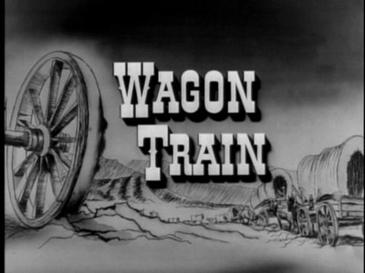Wagon Train is an American Western television series that aired for eight seasons, first on NBC from 1957 to 1962 and then on ABC from 1962 to 1965. Wagon Train premiered on September 18, 1957, and quickly rose to the top of the Nielsen ratings. Also, Wagon Train is one of the top western TV shows of all time. It is a fictional adventure story about a large westbound wagon train traveling from Missouri to California in the American Old West. Its format attracted a variety of famous guest stars who appeared in each episode as travelers or residents of the settlements they visited. The wagon master was originally played by Ward Bond, who was replaced by John McIntire after his death in 1960, and the scout was played by Robert Horton, who was later replaced by Robert Fuller.
About the Wagon Train Series
The series was inspired by John Ford’s 1950 film Wagon Master, which starred Ben Johnson, Harry Carey Jr., and Ward Bond, as well as Raoul Walsh’s 1930 early widescreen film The Big Trail, which starred 23-year-old John Wayne in his first leading role as a buckskin-clad scout and featured Ward Bond in a prominent supporting role. The series influenced the development of Star Trek, which premiered in 1966 as Wagon Train to the Stars. The show’s success was due to the show’s star power, as well as its strong writing and directing. Western novelist Borden Chase and future director Sam Peckinpah were among the writers who developed scripts that became episodes, with experience in other westerns such as Gunsmoke and Tales of Wells Fargo.
The Development of Wagon Train
Revue Productions created a semi-anthology series based on John Ford’s 1950 film Wagon Master, with an emphasis on strong storytelling and quality direction, weekly guest stars are known for their work in motion pictures and other media, and a regular cast of characters to provide a touchstone for audiences. Wagon Train episodes cost over 40% more than most contemporary hour-long Westerns, with an initial budget of US$100,000 per segment (equivalent to $965,000 in 2021), allowing it to film on location in California’s San Fernando Valley and afford its expensive guest stars. In addition, there are also interesting facts about Wagon Train that you need to know.
Each episode focused on characters and personalities who were part of a wagon train caravan from St. Joseph, Missouri to California. Regulars on the show guided the train through perils and adventures associated with the American West’s landscapes and inhabitants. The star vehicle format worked in tandem with series television’s episodic nature, giving viewers a weekly glimpse into the concerns of various pioneers and adventurers. Returning cast members gave the show consistency: audiences expected complaints and comedy from the train’s cook, Charlie Wooster; clashes of experience with exuberance in the wagon master’s relationship with his dashing frontier scouts. The interrelationships, problems, and camaraderie of the recurring cast greatly contributed to the sense of family that tied disparate elements of the series together.
How Long Did Wagon Train Run on Television?
WagonTrain is a Revue Studios-produced American Western television series. The 1950 John Ford film Wagon Master served as inspiration for the series. It aired in the United States for eight seasons, with the first episode airing on September 18, 1957, and the final episode airing on May 2, 1965.
The show’s popularity is evidenced by its ability to survive a network switch and periodic cast changes over the course of its eight-year run. Wagon Train was number one in the United Kingdom two years after its debut, and it was in a constant battle with Gunsmoke for supremacy in the United States, with seven Westerns in the Nielsen top ten. By 1959, the show had firmly established itself in the top twenty-five programs in the country, bouncing as high as number one in the spring of 1960 and maintaining that position over Gunsmoke for the 1961–62 season. Wagon Train established a unique style in a field awash in Westerns, reminiscent of anthology drama but indelibly rooted in Western traditions.
The Overview of Wagon Train
The series follows the journey of a wagon train from St. Joseph, Missouri, to Sacramento, California, via the Midwestern Plains and the Rocky Mountains. It depicts the trials of the regulars from the series who drove the train through the American West. Guest characters portraying members of the massive wagon train or those who come into contact with it are featured in the episodes. Many well-known actors, including Ernest Borgnine, Bette Davis, Jane Wyman, Ronald Reagan, Lee Marvin, and Joseph Cotten, played leading roles. The Willy Moran Story and The Echo Pass Story are two examples of episode titles that highlight the guest characters. As a favor to Ward Bond, film director John Ford joined the show to direct a 1960 segment titled The Colter Craven Story, which features many members of the John Ford Stock Company, including a brief appearance by John Wayne, who is credited as Michael Morris in the credits.
The Release of Wagon Train
1. Original Broadcast
The show aired for 284 episodes over eight seasons, with the first episode airing on September 18, 1957, and the last on May 2, 1965. For the most part, the series was broadcast in black-and-white. That changed briefly during the show’s fifth season, which aired on the NBC network from 1961 to 1962 to promote the sales of parent company RCA’s color television sets.
2. Syndication
Because Wagon Train was still on the ABC evening schedule when the original Ward Bond episodes were broadcast on weekday afternoons on ABC beginning in 1963, the episode was given a new series titled Seth Adams Trailmaster to avoid viewer confusion. These syndicated episodes featured a new theme song, the Trailmaster Theme, written and conducted by Stanley Wilson. Later episodes from the John McIntyre era were syndicated as Trailmaster. After the series ended, all episodes were retitled to their original titles. The 75-minute episodes were usually syndicated separately and occasionally broadcast as movies on local stations.
3. Home Media
Wagon Train was released on DVD in three episodes by Alpha Video in 2004. Timeless Media Group released a DVD collection of 12 episodes on three discs four years later. It also released The Complete Color Season, a 16-disc box set with season seven and 16 episodes from previous seasons, in 2008. Timeless Media Group released the series in eight one-season box sets from 2010 to 2013, with the seventh season missing the bonus episodes.


